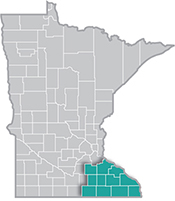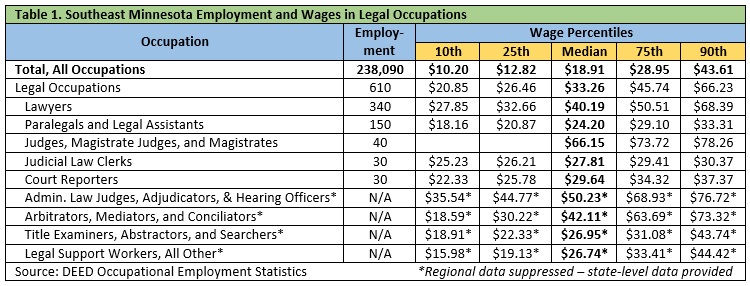 Southeast Minnesota is a health care and agricultural powerhouse. The region is home to the renowned Mayo Clinic and some of the world's most recognized food companies and brands.
Southeast Minnesota is a health care and agricultural powerhouse. The region is home to the renowned Mayo Clinic and some of the world's most recognized food companies and brands.
Advanced manufacturing is especially strong here, with machinery, chemicals, and electronics among the top products.
Want the freshest data delivered by email? Subscribe to our regional newsletters.
8/3/2018 12:00:00 PM
Legal occupations make up a minimal percentage of all employment in Southeast Minnesota, currently accounting for just 0.3 percent of all jobs in the region Nonetheless, it is an important occupational group. There is a wide variety of lawyers with various specialties, such as civil litigation, workers compensation, criminal, immigration, and bankruptcy, as well as occupations for support staff, such as law clerks and paralegals, and the judges that ensure justice is served.
Given the low employment numbers in legal occupations, some employment and wage data from DEED’s Occupational Employment Statistics is suppressed, and thus state-level data was provided in Table 1 below (denoted by the *). Of the legal occupations in which data was available, lawyers showed the largest number of jobs, representing 56 percent of the total legal employment (Table 1).

While employment in legal occupations may be low, wages are relatively high. Not only are the median hourly wages far above those across all occupations, they are all well above the required wage to meet the region’s basic needs cost of living. Even at the 10th percentile, all but one legal occupation offers wages that are higher than needed for the average family (two parents, one working full- and one working part-time, with one child) to meet the basic cost of living needs, currently at $16.17 per hour.
Five legal occupations made the in-demand list for the Southeast region. Lawyers ranked highest at 160th out of 478, while judicial law clerks and paralegals and legal assistants ranked low with a one-star demand indicator – meaning that these occupations see less favorable current demand conditions compared to other occupations.
Post-secondary education seems to be more relevant for these legal occupations compared to on-the-job training requirements. Four of the occupations require education beyond high school, two of which require a doctoral/professional degree. Two occupations require short-term on-the-job training, which the Bureau of Labor Statistics considers as 1-month or less. Training requirements may be different in Minnesota, based on local requirements (Table 2).

The demand rankings reflect that there are currently not many job openings for legal occupations. In fact, less than 1 percent of the job openings in the fourth quarter of 2017 Job Vacancy Survey were in the legal group. Almost all of the vacancies required post-secondary education as well as one or more years of experience, while very few required a certificate or license. This suggests that the openings are for jobs like paralegals and legal assistants or court reporters, rather than lawyers. In addition, and contrary to the current actual earnings data, these legal vacancies have a much lower median wage offer, at $15.20 per hour (Table 3).

Even though occupations in the legal field do not make up a significant portion of total employment in the region, and current openings and demand are relatively low, the need for workers may improve in the near future. As the labor market continues to tighten and older workers continue to leave the workforce, the need to replace those in the legal profession should become more important.
Contact Mark Schultz.